This weekend in Nice on the Promenade des Anglais, the focus was on heart health. The schedule included health paths, medical information booths for prevention, and free screenings. Additionally, demonstrations of “life-saving actions” were conducted by civil protection services, which are crucial to know in order to respond to critical situations.
A typical scenario unfolds: an accident, a body lying on the ground, apparently lifeless. The situation is serious. Immediate action is required. Maurice Chabanne, a 25-year veteran of the civil protection agency, sets the scene. His mission: to explain to passersby who wish to learn the steps to save a person in such a condition.
Securing the perimeter with signs and calling emergency services should then be the first reflexes. To this veteran responder, it’s just common sense: “What’s the use of trying to save someone if you’re not safe yourself in doing so?”
The next step is to analyze the situation and observe the breathing of the individual on the ground. It only takes a few seconds to realize an unconscious state. Loosening the trousers and shirt are essential actions to clear the airways. But there’s still more to do. Demonstrating on a mannequin, Maurice Chabanne explains, “The victim must absolutely have their head tilted back to prevent suffocation.”
In practice, the weight of the tongue can be an obstacle to any attempt at respiration, not to mention the risks posed by potential vomiting. “All these actions only take a few seconds.”
When the time comes to tilt your head towards the face of the unconscious person to check if they are breathing, there’s no response. No signs of life at all. Not even in their hands—which remain inert. There’s no time to waste. If the heart isn’t beating, the only solution left is to perform two rescue breaths—mouth to mouth or mouth to nose, it doesn’t matter. The goal is to restart breathing.
The civil protection officer elaborates, “We must provide what’s necessary to maintain blood oxygenation.” If this approach fails and the individual still isn’t breathing, cardiopulmonary resuscitation is the only chance of survival until medical help arrives. The compression should be applied at the center of the sternum, close to the heart.
To master this delicate step perfectly, the Nice civil protection offers training in its premises located at the entrance of the Ariane district. All life-saving actions are taught there.
First attempt: massage by giving two compressions in the middle of the sternum, then two breaths. If the victim still isn’t breathing, this normally automatic effort falls back to the person assisting them. At a rate of five cycles of 15 compressions followed by two breaths alternately, this massage should last a minute in total.
These movements should be quick and precise. This exercise must be repeated until the arrival of emergency services or until the natural resumption of the unconscious person’s breathing. Such actions help keep the heart artificially active. Maurice Chabanne does not hesitate to provide astounding figures: “These simple gestures save lives in 60% of cases. They shouldn’t be overlooked.”


